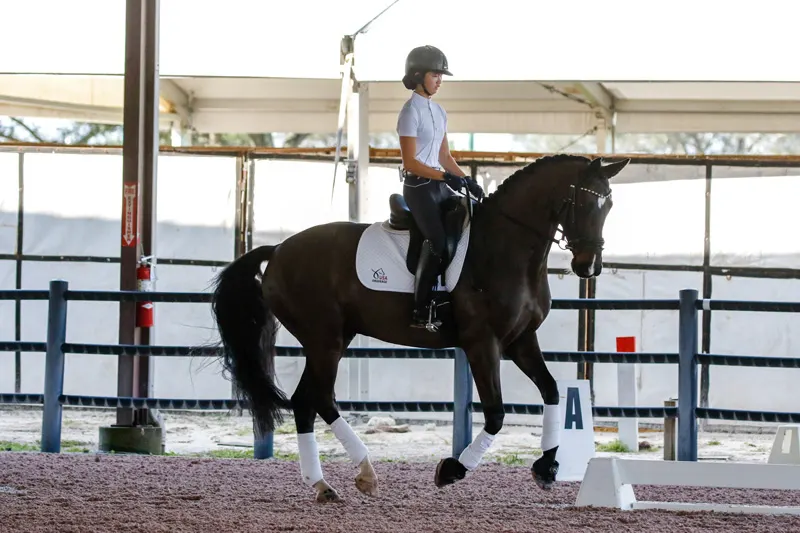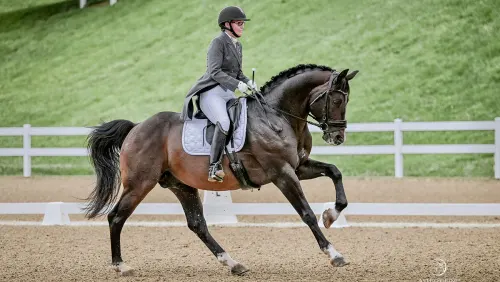Wellington, Fla.—Jan. 3
A decade after it first began, Robert Dover’s Horsemastership Week still attracts eager, young talent anxious to learn from some of the top names in dressage.
Dover’s first-day schedule historically includes a chat about the fundamentals of dressage while audience members tentatively answer his questions. As always, it comes down to the half-halt, which Dover described as a doorway through which bend, balance, gait, pace and movement are accomplished.
“If you can ride the perfect half-halt, there is nothing you can’t do,” he said. “The half-halt is the end game.”
Then it was time for the 11 young riders to demonstrate their half-halting and half-passing abilities while riding one-on-one with clinicians Dover, Katherine Bateson-Chandler or George Williams in the Van Kampen Arena at the Adequan Global Dressage Festival showgrounds.
The Adjustability Half-Halt
Kayla Kadlubek from Fairfax Station, Virginia, was first in the hot seat as she practiced taking deep breaths before she entered the arena with Dover watching. The pair worked on adjustability and the effectiveness of half-halts with Dover’s famous rubber band exercise in which the horse transitions within a gait on a circle.
He directed the Kadlubek to pick up the right-lead medium canter; then he told her to collect with a half-halt and ride three strides of a “pirouette” canter while maintaining contact with the outside rein.
“The beauty of the well-trained horse is that in every step of his most collected gait, like the canter, he will have the ability and the desire to do the extended canter,” Dover said and added that a half-halt doesn’t result in the loss of engagement but rather in the gain of engagement.
The Definitive Half-Halt
Williams worked with Callie Jones from Henderson, Kentucky, and her own Don Philippo, a 12-year-old Hanoverian gelding (Dancier—Wildnight), on lead changes in a series on a circle.
The first two of the series were easy for the duo, but the third required a firmer, clearer and more definite half-halt to achieve the goal.
ADVERTISEMENT
“A lot of it is how you think,” Williams said. “It can’t just be a kick with the leg to make it happen. He has to stay balanced, and he has to stay organized. I think it’s important for you to work with the changes so he stays a little more up.”
The Balancing Half-Halt
Miki Yang of Los Altos Hills, California, rode the Ravel son Rapsodie Espagnole with Katherine Bateson-Chandler who told Yang to think about the horse’s balance so that he pushes up and forward from his hind end.
When halting, the horse “slid back” a bit, and Bateson-Chandler advised Yang to make sure the last step is a “walk-forward” step.
Then, in the corners, he started to lean on his forehand. “In the corner, when he starts to run downhill again, ride the half-halt,” Bateson-Chandler said. “If you feel he runs through that, then halt again. Then, walk forward in that balance. He has to push up and carry himself.”
She had Yang ride small steps into the corners to help him keep his balance, telling her to sit him back on his hind end a little bit each time. “Get a little greedier in your half-halt. Don’t be afraid to bring him back.”
Yang needed to use more leg, not just steer with her hands, and to find the feeling of moving her hands forward without feeling a difference in the reins.
“Any opportunity you have to push your hands forward and say, ‘Balance,’ take that opportunity until you feel like you can soften with your hand, and his frame doesn’t change,” Bateson-Chandler said. “You want him so on your seat that you can soften that hand an inch forward and your fingers don’t change. If you feel like he pulls through and ignores you, bring him back and halt him once. Don’t let him feel like he’s just allowed to pull through you.”
She had Yang ride a four-loop serpentine on the right lead and told her to stop the gelding from running through her hands and then to soften the contact. “Take those opportunities where he feels really balanced on your seat to move your hand forward,” Bateson-Chandler said. “He’s got to listen to that half-halt.”
When Bateson-Chandler had Yang start doing changes in the serpentine, she encouraged her to be bold. “Imagine it’s a show jump, and, if he runs through you, don’t be afraid to do something about it.”
The Imaginative Half-Halt
Lexie Kment, 13, from Palmyra, Nebraska, is the youngest participant in the Horsemastership Week. Dover was impressed with her riding skills and by her horse, Manatee (Man From Eldorado—New Traditions), a 17-year-old Thoroughbred gelding owned and trained by her mother, Jami Kment.
ADVERTISEMENT
Dover told Lexie to imagine the most fabulous extended trot ever. “So you breathe in, you close your legs, you close your fist, you half-halt, and you create that which you desire,” he said. “You have to see it as a visual in your mind like a movie.”
Then, they practiced the rubber band exercise to keep “Manny” within the trot but extending, then collecting and then extending again.
They worked on transitions from canter to walk, using the half-halt. “Now you’re going to think of this collection into your walk,” said Dover. “Remember it’s leg and then close your fist. Taking a breath. Taking a breath. Now walk.”
The Half-Pass Deadly Sin
Bianca Schmidt from Edina, Minnesota, rode Eliana Schmidt’s Lou Heart (Londonderry—Darjeeling), a 16-year-old Hanoverian gelding with Bateson-Chandler.
Issues with the horse falling in prompted Bateson-Chandler to instruct Bianca to make sure she used her inside leg and her outside rein to keep him straight.
”They always want to curl around the inside leg, so make sure you are always riding that inside hind leg toward the outside front leg,” Bateson-Chandler said.
She had Bianca canter down the centerline holding the horse super straight, and then leg yield him away from the centerline. Thought it would never be ridden in a test, it’s a useful exercise to address leaning. “That’s to get him a little bit more through off your outside leg,” said Bateson-Chandler.
For the half-pass they focused on preparing and keeping the haunches in as they moved diagonally. “It’s got to be starting in a little bit shoulder-fore, and you’ve got to keep those shoulders,” said Bateson-Chandler. “Don’t let the haunches lead in this. It’s like the deadly sin. Sit behind him. Make him canter out in front of you. Make sure the forehand is ahead, and you get pulled toward the wall. You’ve got to have the shoulder-fore in your half-pass. Push to the wall, push to the wall, all the way!”
And like the other trainers and riders, Bateson-Chandler advocated for tons of tiny little gear changes forward and back, but there was no more talk of other deadly sins.
The riders will continue the clinic experience on Jan. 3 and 4, rotating their instructors. On Jan. 5, they will put their new skills to work as they ride through a test.

















